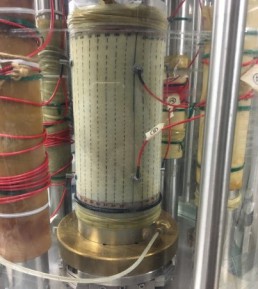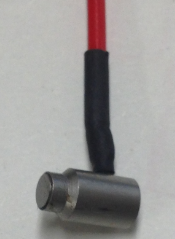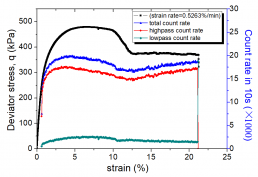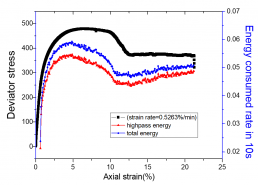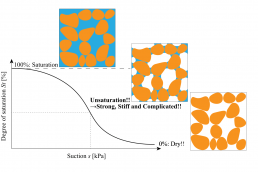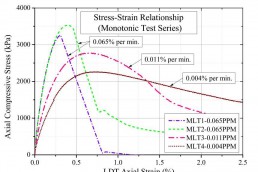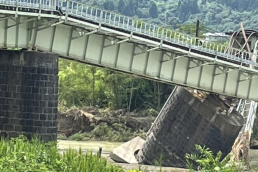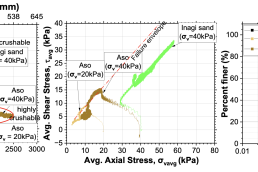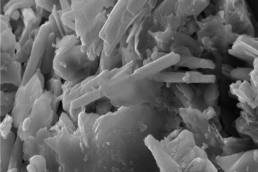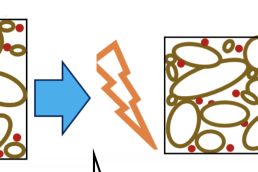Introduction / 序論
Over the last few decades, significant prior researches have been conducted to investigate the progressive failure of sands. The mechanical failure, i.e. strain localization and shear banding, of sandy soil is the macroscopical manifestation of the complex internal particle dislocation motions with respect to particle movements (sliding and rotation) or / and micro-defect growth (breakage of asperities and particle fragmentation). Monitoring the micro-behavior between particles during the bifurcation process would be expected as a powerful technique to study fundamental details of initiation and evolution of shear banding in sandy soil. Starting with this premise, a non-destructive testing method, Acoustic Emission (AE) technology, is proposed to characterize the internal micro-mechanism of sandy soil during shear banding in drained-triaxial compression tests (as shown in Fig.1).
砂の破壊挙動に関して,これまでに数多くの研究が実施されている.砂供試体の力学的破壊,たとえば,ひずみ局所化やせん断帯形成は,粒子の移動(滑動と回転)や変状(粒子破砕)を含んだ複雑な微視的構造の変化の現れである.砂材料におけるせん断帯の形成と発達過程を調べる上で,これら粒子間の微視的な挙動をモニタリングすることは非常に有効であると考える.このような考察から,非破壊検査であるアコースティックエミッション(AE)技術を用い,三軸条件での砂のせん断帯形成における内部構造変化の観察に取り組んでいる(図1を参照).
(a)Triaxial apparatus
(b)Soil sample
(c)AE sensor
Fig.1 Devices used for triaxial compression tests
AE event rates and AE energy rates / AEイベント速度とAEエネルギー速度
AE refers to the elastic wave generated by a sudden release of stored strain energy from a stressed material. In case of triaxial compression, AE activities are prone to be generated by aforementioned particle movements (sliding and rotation) or/and micro-defect growth (breakage of asperities and particle fragmentation) within the soil body. Previous investigations showed that the failure progress of sand is highly emphasized by frequency properties of AE signals, in which particles crushing are significantly dominant by high frequency signals, while particles sliding are dominant by low frequency signals (Mao & Towhata (2015)). Therefore, high pass filter and low pass filter are applied in raw signals to separate particle crushing and sliding. Insights related to the mode, degree and rate of the internal particle movement and failure evolution can be offered in terms of AE event rates and AE energy rates and results are shown in Fig.2. The result demonstrated that AE monitoring is capable of delivering beneficial information to assess the process of progressive failure in sandy soil and give a clear indication of inter-particle dislocation regarding with sliding and crushing during shear banding.
AEでは,変形・破壊時のひずみエネルギーの解放によって生じる弾性波(音波)を計測し,特に三軸圧縮下では前述の粒子移動や変状を感知する傾向にある.既往の検討(Mao & Towhata (2015))では,砂の破壊進行はAEシグナルの周波数特性と関連しており,粒子破砕は高周波,一方で粒子滑動は低周波であることが示された.本研究では,周波数をフィルターで分類することでそれぞれの発生を区別した.その結果,粒子の移動と破壊進行は,AEイベントの頻度とAEエネルギー変化と相関があることが分かった(図2).以上から,AEモニタリングを用いることで,粒子の微視的構造変化,特に移動と破砕を適切に区別して評価することが可能となり,砂供試体の複雑な変形破壊進行について貴重な情報を得ることができる.
(a)
(b)
Fig.2 Evolutions of AE activities during Triaxial compression:
(a) total, high frequency and low frequency AE count rate; (b) total and high frequency energy rate
The extension of present work / 今後の予定
The extension of present work is currently focused on exploring an automated processing technique to three-dimensionally localize the AE source event (source generation time and location) within the soil body to visualize the initiation and evolution of shear banding, which would help facilitate in predicting and preventing the progressive failure of sandy subsoil under compression.
Interested readers are referred to LIN, et al (2016) and Lin, et al (2017).
これらの結果をベースにして,現在は砂供試体内部で発生するAEイベントの位置の抽出に取り組んでおり,最終的にはせん断帯の形成から発達を三次元的に可視化することを目標としている.
参考文献:LIN, et al (2016) and Lin, et al (2017)
More Details...
1)Lin Wenli, Wuwei Mao, and Junichi Koseki. “Acoustic Emission Technology to Investigate Internal Micro-Structure Behaviour of Shear Banding in Sands.” Advances in Laboratory Testing and Modelling of Soils and Shales. Springer, Cham, 2017.
2)Mao, Wuwei, and Ikuo Towhata. “Monitoring of single-particle fragmentation process under static loading using acoustic emission.” Applied Acoustics 94 (2015): 39-45.
3)Wenli LIN, Junichi KOSEKI, and Wuwei MAO. “ACOUSTIC EMISSION RESPONSE DURING SHEAR BAND FORMATION IN TRIAXIAL COMPRESSION TEST ON SAND.” Proceedings of the 18th International Summer Symposium.p77-78, 2016.09.

